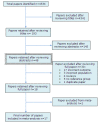Second hand smoke exposure and the risk of invasive meningococcal disease in children: systematic review and meta-analysis
- PMID: 23228219
- PMCID: PMC3534009
- DOI: 10.1186/1471-2458-12-1062
Second hand smoke exposure and the risk of invasive meningococcal disease in children: systematic review and meta-analysis
Abstract
Background: Invasive meningococcal disease remains an important cause of serious morbidity and mortality in children and young people. There is a growing body of literature to suggest that exposure to passive smoke may play a role in the development of the disease, therefore we have performed a systematic review to provide a comprehensive estimate of the magnitude of this effect for smoking by any household member, by individual family members, and of maternal smoking before and after birth.
Methods: Four databases (Medline, Embase, PsychINFO and CAB Abstracts database) were searched to identify studies (to June 2012) and reference lists scanned for further studies. Titles, abstracts and full texts were checked for eligibility independently by two authors. Quality of included studies was assessed using the Newcastle-Ottawa Scale. Pooled odds ratios (OR) with 95% confidence intervals (CI) were estimated using random effect models, with heterogeneity quantified using I2.
Results: We identified 18 studies which assessed the effects of SHS on the risk of invasive meningococcal disease in children. SHS in the home doubled the risk of invasive meningococcal disease (OR 2.18, 95% CI 1.63 to 2.92, I2 = 72%), with some evidence of an exposure-response gradient. The strongest effect was seen in children under 5 years (OR 2.48, 95% CI 1.51 to 4.09, I2 = 47%). Maternal smoking significantly increased the risk of invasive meningococcal disease by 3 times during pregnancy (OR 2.93, 95% CI 1.52-5.66) and by 2 times after birth (OR 2.26, 95% CI 1.54-3.31).
Conclusions: SHS exposure, and particularly passive foetal exposure to maternal smoking during pregnancy, significantly increases the risk of childhood invasive meningococcal disease. It is likely that an extra 630 cases of invasive meningococcal disease annually in children under 16 are directly attributable to SHS exposure in UK homes.
Figures






References
-
- Health Protection Agency. Stauatory notifications of Infectious Diseases in England and Wales. 2009. Available from: http://www.hpa.org.uk/web/HPAwebFile/HPAweb_C/1281952671504.
-
- Grimwood K, Anderson VA, Bond L, Catroppa C, Hore RL, Keir EH. et al.Adverse outcomes of bacterial meningitis in school-age survivors. Pediatrics. 1995;95:646–656. - PubMed
Publication types
MeSH terms
Substances
Grants and funding
LinkOut - more resources
Full Text Sources
Medical

